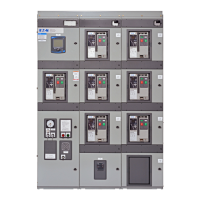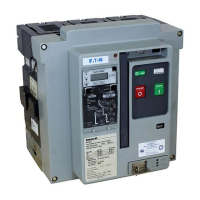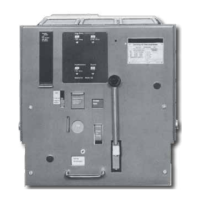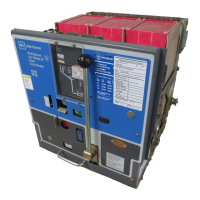8
1
1
1
1
1
1
1
1
1
1
1
1
1
1
1
1
1
1
1
1
1
1
MAGNUM PRODUCT GUIDE CA013002EN—April 2017 www.eaton.com 53
Accessory devices and connections
•
Spring Release (SR)
The spring release is an optional device. It remotely closes the
circuit breaker when the coil is energized by a voltage input.
The closing spring must be fully charged and the trip latch
reset (not held in the tripped position) for the spring release to
operate. If these two conditions are not met, the close signal
will be ignored until it is removed and re-applied.
An optional Latch Check Switch (LCS) can be installed to
indicate when the breaker is “ready to close.” The LCS wired
to the spring release will not permit activation of the spring
release until the breaker is fully charged and the trip latch is
reset. If power is applied and maintained to the spring release,
activation will occur when the breaker is “ready to close.”
The LCS for remote indication consists of one Form C contact
wired to the circuit breaker secondary contacts for integration
into external control schemes.
ote:N Wiring the LCS for remote indication directly in series with the
SR accessory is not recommended, as this will override the “anti-
pump” feature of the electrical charging/closing system.
ote:N Do not use a monitoring circuit on a spring release.
Spring release with optional latch switch
Table 15. Spring release ratings
Control
voltages
Operational
voltage range
85 –110%
Inrush/
continuous
power
consumption
Opening
time
24 Vdc 20–26 Vdc 250 W 40
48 Vdc 41–53 Vdc 250 W 40
60 Vdc 51–66 Vdc 300 W 40
110–125 Vdc 93–138 Vdc 450 W 40
220–250 Vdc 187–275 Vdc 450 W 40
110–127 Vac 93–140 Vac 450 VA 40
208–240 Vac 177–264 Vac 450 VA 40
•
Undervoltage Release (UVR)
The undervoltage release is an optional device on both
manually and electrically operated circuit breakers. It opens
the breaker when its supply voltage falls to between 35–60%
of rated voltage. If the release is not energized to 85% of its
supply voltage, the circuit breaker cannot be closed electrically
or manually.
Table 16. Undervoltage release ratings
Control
voltages
Operational
voltage
range
85 –110%
Dropout
voltage
30–60%
Inrush/
continuous
power
consumption
Opening
time (ms)
24 Vdc 20–26 Vdc 7–14 Vdc 250 W/18 W 70
32 Vdc 27–35 Vdc 10–19 Vdc 275 W/15 W 70
48 Vdc 41–53 Vdc 14–29 Vdc 275 W/18 W 70
60 Vdc 51–66 Vdc 18–42 Vdc 275 W/18 W 70
110–125 Vdc 94–138 Vdc 33–75 Vdc 450 W/10 W 70
220–250 Vdc 187–275 Vdc 66–150 Vdc 450 W/10 W 70
110–127 Vac 94–140 Vac 33–76 Vac 450 VA/10 VA 70
208–240 Vac 177–264 Vac 62–144 Vac 400 VA/10 VA 70
380–415 Vac 323–457 Vac 114–249 Vac 480 VA/10 VA 70
480 Vac 408–528 Vac 144–288 Vac 400 VA/10 VA 70
600 Vac 510–660 Vac 180–360 Vac 400 VA/10 VA 70
Required for 200 ms
Required for 400 ms
Undervoltage release
All Three Accessories (ST, SR, UVR) Installed
1 2
2
2
2
2
2
1
2
Courtesy of NationalSwitchgear.com

